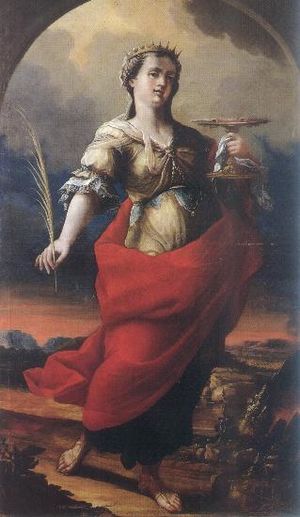Evaristo Muñoz facts for kids
Evaristo Muñoz Estarlich (born in Valencia, Spain, in 1684 – died in Valencia, Spain, in 1737) was a talented Spanish painter. He was known for his beautiful Baroque style, which was a very decorative and grand way of painting popular at the time. He followed the artistic ideas of Antonio Palomino, another famous painter in Valencia. Some people believe he was born in 1671 instead of 1684.
Early Life and Career
Evaristo Muñoz Estarlich studied painting with Juan Conchillos, a well-known artist. Besides being a painter, Evaristo was also quite skilled in other areas. He was known as a good dancer and a theatrical performer. He was also a talented fencer.
In 1709, he moved to Palma de Mallorca. There, he worked on painting the chapel for Holy Communion at the Convent of San Francisco. During this time, he got married. However, his marriage faced a problem when his wife's first husband, who was thought to be gone, reappeared. Because of this, Evaristo had to return to Valencia. On his journey back, he even served as a soldier for a while, but he never stopped painting.
Life in Valencia
After returning to Valencia, Evaristo Muñoz Estarlich settled down permanently. He dedicated his life to painting and teaching art. He even had his own private drawing school at his home. Many famous artists learned from him at his school. Some of his well-known students included Ignacio Vergara, Hipólito Rovira, and Cristóbal Valero.
Evaristo created many artworks during his life. Sadly, not all of them have survived until today. However, some of his important paintings can still be seen. These include "The Banquet of Wenceslaus of Luxembourg" and "The Martyrdom of St. John of Nepomuk". Both of these paintings are on the walls of St. John's chapel at the Iglesia de San Juan de la Cruz in Valencia. Another notable work is "The Apparition of St. Augustine and St. Thomas Aquinas", which is part of the collection at the Museo de Bellas Artes de Valencia.
In 2010, four paintings showing scenes from the childhood of Jesus were restored. These paintings are now believed to be Evaristo's work. They were originally thought to have been painted by Luca Giordano, another famous artist. These artworks were kept at the Museum after a historical event called the Spanish confiscation.
See also
 In Spanish: Evaristo Muñoz para niños
In Spanish: Evaristo Muñoz para niños


